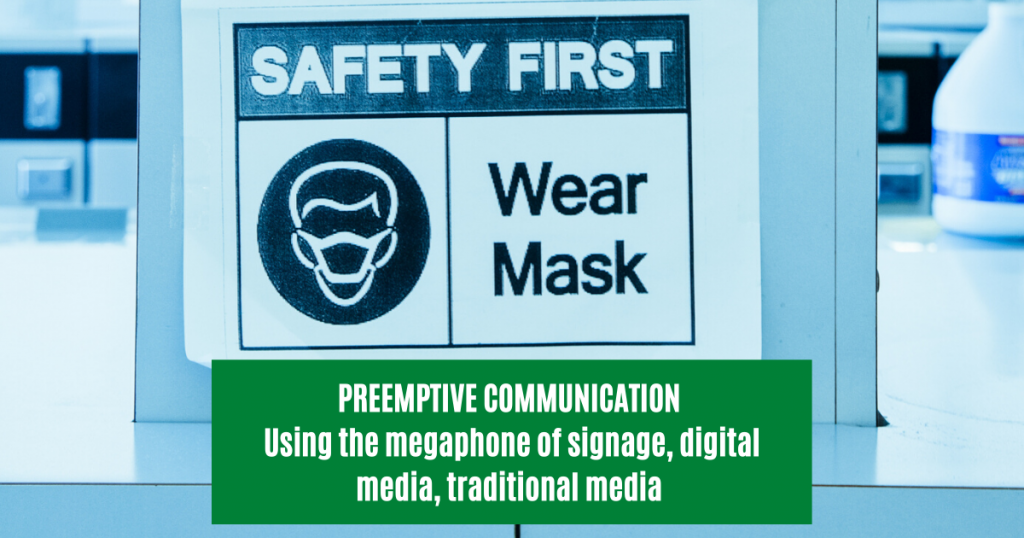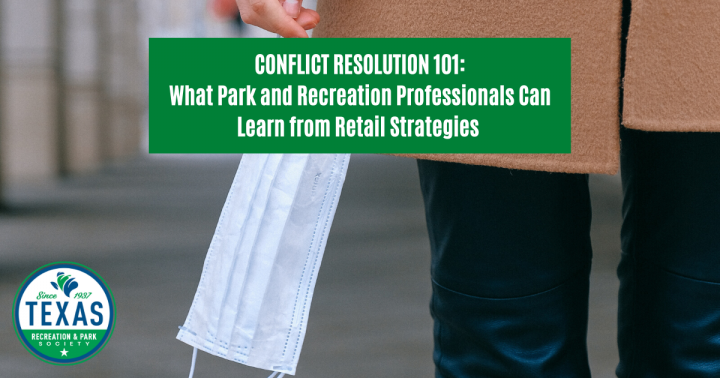While communities across Texas grapple with the realities that COVID-19 brings to everyday activities, it’s not surprising that park and recreation professionals are caught in the crossfire. Compliance with the guidelines provided by the state, county and cities in which recreation centers, playgrounds and other public spaces are now included in new daily duties, despite rising tensions regarding the guidelines.
What guidance should be given to help de-escalate these tensions? How can frontline park and recreation staff follow directives from the organization they serve in the safest way possible? Here’s a list of conflict resolution techniques that can serve as a training baseline as our communities work together to stop the spread and recreate responsibly.

Clear communication in its many fronts is a good foundation to preempt potential problems your staff may encounter with members of the community that do not want to comply with federal, state and county guidelines. It’s important to remember that that communication is not just speaking.
Posting signs outside public spaces and recreation facilities that clearly lay out expectations will alert public space users of your organization’s expectations before they enter the space.
Some tips for great signage:
- Use symbols in addition to text.
- Use friendly, eye-catching colors. Red and other types of bold colors tend to illicit reactions of anxiety or alarm.
- Depending on the demographics of your public space, make sure to create text in multiple languages
- Consider also posting signs in braille or have a staff member available to assist persons with visual or hearing impairments
The county and city public information offices should also be included in your communication strategy. There are many tools in their tool chest to help assist you with media engagement and alerts to deliver your message before public space users come on to the site. Whether through press releases, public briefings from city, county or elected officials, public information officers can help create a message, disseminate it to the media for interviews and assist with any interviews or direct communication to the media. Make sure to select a well-trained staff member to serve as the spokesperson for the media.
What to include in public information dissemination:
- The facilities affected by the guidelines
- Any changes to hours of operations affected by the guidelines
- If available, a timeline for how long these operational changes will be in effect
- Any staff member that speaks to the media should wear clothing with the organization’s branding clearly displayed
Don’t forget the power of social media when practicing preemptive communication. During the months of lockdown and re-opening, consumers from all walks of life have relied on social media to discover the most updated information from cities, their favorite shops, restaurants and bars. County and cities can also benefit from using social media to similarly get the message across thousands of people in your community.
Tips for social media/digital marketing messaging
- If creating graphics, design the graphic to the size dimensions of the social media channel utilized
- Consider making a video utilizing park and recreation staff members to deliver a comprehensive and engaging message; make sure that the staff members are portrayed in the video complying with the guidelines (i.e., wearing masks, social distancing, washing or sanitizing hands)
- Incorporate similar information included in signage and public information dissemination
Change operating hours on social media channels, on the organization’s website site and on Google.com

Despite following best practices for preemptive communication, there is ample evidence that public space users are struggling to comply with the mandated guidelines for social distancing and stopping the spread of COVID-19. As Texas deals with the ramifications of pausing its re-opening progress due to the current spike in cases affecting the public health of the state, this has increased the anxiety and frustrations of many Texans. And this frustration can definitely spill over into park and recreation organizations’ interactions with the public.
It is incumbent on the organization to set the staff up for success in dealing with these heightened interactions during this uncertain time. Having a strategy in place from the outset will not only potentially deescalate the conflict, it will also protect an organization’s staff. A solid training program for conflict resolution should include training in direct communication during the conflict, what to do when the interaction cannot be deescalated and a defined safety plan for staff and other users who may be affected by the interaction. Establishing these protocols will force leaders to clarify their own expectations and will give the staff clear guidance on how they are expected to perform during these situations.
As organizations’ work to establish protocols, there are some general communication skills that can be easily implemented and should be considered.
One of the most important aspects of communication is listening. As noted above, speaking is only one side of communication and very often communication breaks down when only one side of communication is being utilized. By focusing on active listening, an organizations’ staff can help slow down the agitated user’s frustrations and anxiety just by making them feel heard.
Being an active listener requires empathy and projecting empathy while listening incorporates many non-verbal communication techniques. Standing in an open, non-threatening fashion (6 feet away), head nodding while the agitated person is speaking and keeping hands to the side (not crossed across the body) are examples of projecting empathy. And even though masks are a requirement, the listener’s eyes and eyebrows are assets in non-verbal expressing empathy. It’s important to maintain a soft, engaged eye contact while actively listening and raised eyebrows can convey concern for the agitated user’s well-being.
When it becomes a staff member’s turn to speak, it’s important that the tone of voice is soft, steady, calm yet firm. Speaking in clear, thought-out sentences is much better than short, abrupt, clipped ones. After mastering tone, staff should be trained in what specifically to say in these situations. Organizations can help their staff by providing them with prepared, generalized statements and remarks that can be delivered in a variety of scenarios. Examples of these generalized statements include:
- “I understand that you’re upset by these guidelines, but unfortunately we must comply with the (City, County, State) guidelines for the well-being of the community.”
- “If you would like to discuss this further with my (supervisor, director), I can give you his/her contact information.”
- “Let me see if I understand you correctly…” and then repeat the specific concerns back to agitated user; this tactic is called reflective language

It is also very important that an organization’s staff is a subject matter expert in the guidelines that govern the specific county and city where the conflict occurs. This knowledge will give the staff confidence to effectively communicate with any public space user (agitated or otherwise) and will be extremely useful should an interaction become escalated. If staff can quickly and easily list the guidelines in a heightened interaction, they will not have to think twice or second-guess their expertise.
For additional information, this 44-minute video provides some robust strategies and tactics that organizations can take to help set their staff up for success during any type of conflict during these times. While it’s designed specifically for retail spaces, there are many practical applications that park and recreation professionals can put into place in their own organizations. Click here to view the video.
One final note: This time is stressful for everyone. Staff members should be given a safe space to communicate with their supervisors and their colleagues about their own anxieties and fears in managing the front lines. The organization’s leaders should practice the same communication steps listed above when listening to their staff’s concerns while managing this process with the public. Mental health first aid stations, paid-time off and other tactics should be employed to help keep staff in the best frame of mind to handle these stressors that have gripped our communities since the outbreak of COVID-19.
Resources
https://www.mycustomer.com/community/blogs/colin-shaw/10-ways-to-deal-with-customers-during-covid-19
https://deanofstudents.catholic.edu/wellness/healthy-relationships/communication.html

